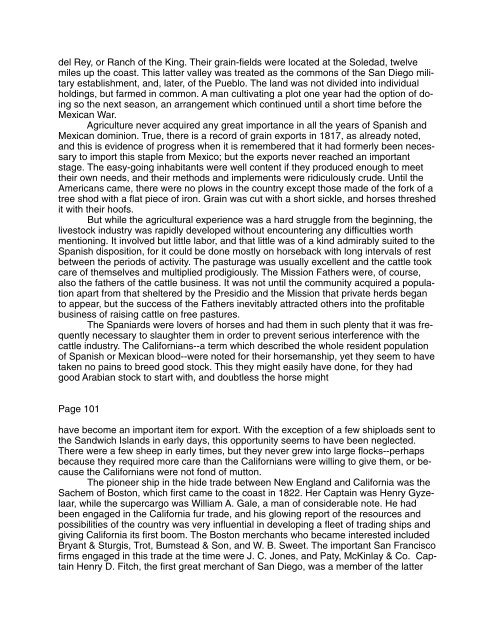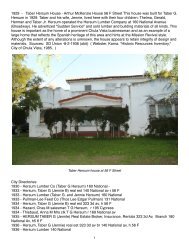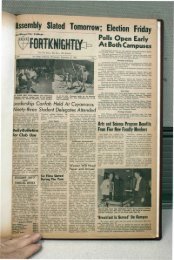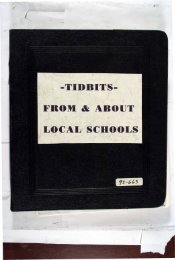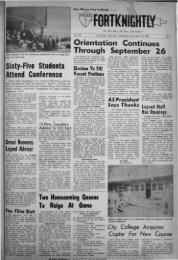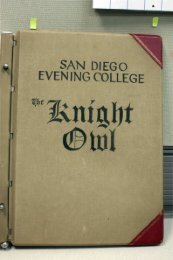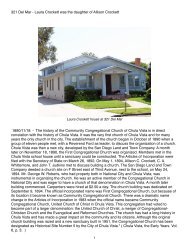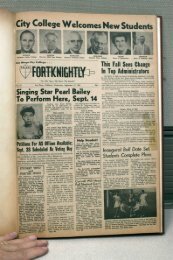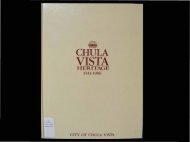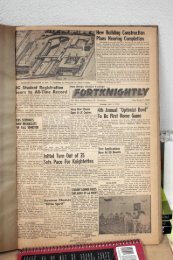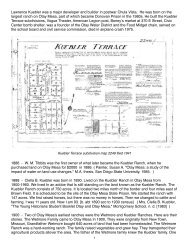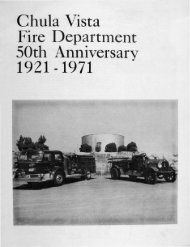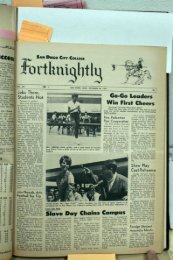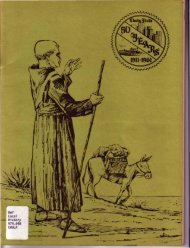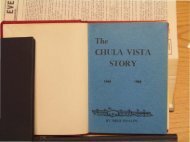doc241 - Schoenherr Home Page in Sunny Chula Vista
doc241 - Schoenherr Home Page in Sunny Chula Vista
doc241 - Schoenherr Home Page in Sunny Chula Vista
You also want an ePaper? Increase the reach of your titles
YUMPU automatically turns print PDFs into web optimized ePapers that Google loves.
del Rey, or Ranch of the K<strong>in</strong>g. Their gra<strong>in</strong>-fields were located at the Soledad, twelve<br />
miles up the coast. This latter valley was treated as the commons of the San Diego military<br />
establishment, and, later, of the Pueblo. The land was not divided <strong>in</strong>to <strong>in</strong>dividual<br />
hold<strong>in</strong>gs, but farmed <strong>in</strong> common. A man cultivat<strong>in</strong>g a plot one year had the option of do<strong>in</strong>g<br />
so the next season, an arrangement which cont<strong>in</strong>ued until a short time before the<br />
Mexican War.<br />
Agriculture never acquired any great importance <strong>in</strong> all the years of Spanish and<br />
Mexican dom<strong>in</strong>ion. True, there is a record of gra<strong>in</strong> exports <strong>in</strong> 1817, as already noted,<br />
and this is evidence of progress when it is remembered that it had formerly been necessary<br />
to import this staple from Mexico; but the exports never reached an important<br />
stage. The easy-go<strong>in</strong>g <strong>in</strong>habitants were well content if they produced enough to meet<br />
their own needs, and their methods and implements were ridiculously crude. Until the<br />
Americans came, there were no plows <strong>in</strong> the country except those made of the fork of a<br />
tree shod with a flat piece of iron. Gra<strong>in</strong> was cut with a short sickle, and horses threshed<br />
it with their hoofs.<br />
But while the agricultural experience was a hard struggle from the beg<strong>in</strong>n<strong>in</strong>g, the<br />
livestock <strong>in</strong>dustry was rapidly developed without encounter<strong>in</strong>g any difficulties worth<br />
mention<strong>in</strong>g. It <strong>in</strong>volved but little labor, and that little was of a k<strong>in</strong>d admirably suited to the<br />
Spanish disposition, for it could be done mostly on horseback with long <strong>in</strong>tervals of rest<br />
between the periods of activity. The pasturage was usually excellent and the cattle took<br />
care of themselves and multiplied prodigiously. The Mission Fathers were, of course,<br />
also the fathers of the cattle bus<strong>in</strong>ess. It was not until the community acquired a population<br />
apart from that sheltered by the Presidio and the Mission that private herds began<br />
to appear, but the success of the Fathers <strong>in</strong>evitably attracted others <strong>in</strong>to the profitable<br />
bus<strong>in</strong>ess of rais<strong>in</strong>g cattle on free pastures.<br />
The Spaniards were lovers of horses and had them <strong>in</strong> such plenty that it was frequently<br />
necessary to slaughter them <strong>in</strong> order to prevent serious <strong>in</strong>terference with the<br />
cattle <strong>in</strong>dustry. The Californians--a term which described the whole resident population<br />
of Spanish or Mexican blood--were noted for their horsemanship, yet they seem to have<br />
taken no pa<strong>in</strong>s to breed good stock. This they might easily have done, for they had<br />
good Arabian stock to start with, and doubtless the horse might<br />
<strong>Page</strong> 101<br />
have become an important item for export. With the exception of a few shiploads sent to<br />
the Sandwich Islands <strong>in</strong> early days, this opportunity seems to have been neglected.<br />
There were a few sheep <strong>in</strong> early times, but they never grew <strong>in</strong>to large flocks--perhaps<br />
because they required more care than the Californians were will<strong>in</strong>g to give them, or because<br />
the Californians were not fond of mutton.<br />
The pioneer ship <strong>in</strong> the hide trade between New England and California was the<br />
Sachem of Boston, which first came to the coast <strong>in</strong> 1822. Her Capta<strong>in</strong> was Henry Gyzelaar,<br />
while the supercargo was William A. Gale, a man of considerable note. He had<br />
been engaged <strong>in</strong> the California fur trade, and his glow<strong>in</strong>g report of the resources and<br />
possibilities of the country was very <strong>in</strong>fluential <strong>in</strong> develop<strong>in</strong>g a fleet of trad<strong>in</strong>g ships and<br />
giv<strong>in</strong>g California its first boom. The Boston merchants who became <strong>in</strong>terested <strong>in</strong>cluded<br />
Bryant & Sturgis, Trot, Bumstead & Son, and W. B. Sweet. The important San Francisco<br />
firms engaged <strong>in</strong> this trade at the time were J. C. Jones, and Paty, McK<strong>in</strong>lay & Co. Capta<strong>in</strong><br />
Henry D. Fitch, the first great merchant of San Diego, was a member of the latter


